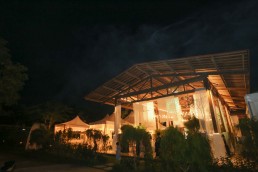Oct 22, 2019
The 5 absolute must have indoor plants to purify air in your home and office
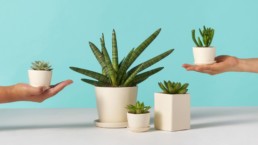

There are tons of articles on indoor plants. We know how busy life is. Here’s our top 5 plants that does not require tons of maintenance. They don't wither easily even if you forget to water them for a day or two.
For starters, we recommend choosing a plant based off the conditions your space provides. If you’re thinking of getting a plant to furnish your window sill or balcony that receives direct sun all day long, choose one that thrives in dry & sunny conditions, like an like an echeveria or haworthia (two popular types of succulents).
One 2015 study in the Journal of Physiological Anthropology found that interacting with indoor plants can reduce both physiological and psychological stress. Plus, plants are great at purifying the air in your home, office or working space by filtering out everyday pollutants.
So, what are you waiting for? Add these indoor plants to your home and start reaping all the healthy benefits while making your space looking more alive than ever.
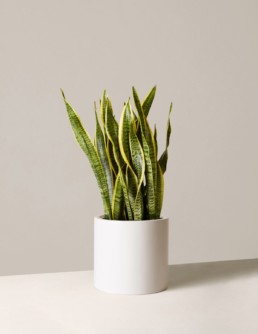
Snake Plant
Don’t let the name fool or scare you. The snake plant simply gets its name from the thin, upright leaves with “irregular green banding” that look like—you guessed it—snakeskin.
Besides looking cool, it’s a low-maintenance plant that’s known for surviving droughts, making it perfect for newbies living in almost any environment.
Snake Plants convert CO2 into oxygen at night (as opposed to most other plants) so they are the ideal plant to brighten up a bedroom and help you sleep better by breathing cleaner, oxygen-rich air all night long.
The Snake Plant is recommended by NASA’s Clean Air Study for it’s air purifying attributes. Add one (or a combination of different purifying plants) for every 100 sq. ft. of indoor space and say goodbye to 90% of your indoor toxins! This hard-working plant specifically filters formaldehyde, trichloroethylene, xylene, and benzene from the air.
Light
Thrives in medium to bright indirect light, but can tolerate low indirect light.
Water
Water every 2-3 weeks, allowing soil to dry out between waterings. Increase frequency with increased light.
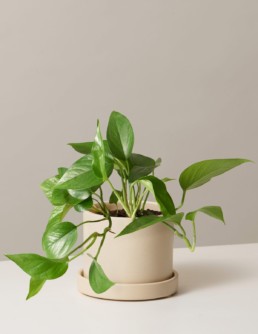
Pothos Plant
Pothos is arguably the easiest of all houseplants to grow, even if you are a person who forgets to water your plants. This trailing vine has pointed, heart-shaped green leaves, sometimes variegated with white, yellow, or pale green.
While pothos likes bright, indirect light it can thrive in areas that don’t get a lot of sunlight or have only fluorescent lighting. It’s an excellent plant for locations such as offices and dorm rooms. One advantage of growing pothos is that they are high on the list of plants that can help purify indoor air of chemicals such as formaldehyde, trichloroethene, toluene, xylene, and benzene.
As an added bonus, this plant is super easy to grow and propagates (translation: breeds more pothos) in water. While you’ll need to learn how to propagate a Pothos plant, you can basically get as many plants as you want for the price of one. And like the snake plant, the pothos filters benzene, formaldehyde, xylene, and toluene.
Light
Thrives in medium to low indirect light. Not suited for intense, direct sun.
Water
Water every 1-2 weeks, allowing soil to dry out between waterings. Increase frequency with increased light.
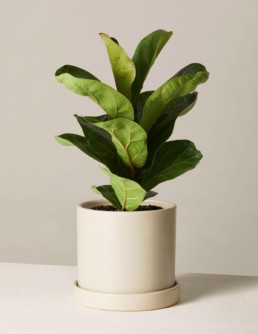
Fiddle Leaf Fig
The Fiddle Leaf Fig is characterized by its broad, vibrant green leaves with prominent veining. It prefers a stable environment and can be fickle when temps fluctuate.
Some people find ficus and fig trees were boring and ugly. While they’re of the same family tree, fiddle leaf fig is a very visually appealing plant that is casual enough for any decor.
Due its broad leaves it is extremely efficient at purifying air, and is highly rated for indoor and office use. Another benefit of the fiddle leaf is that it helps control humidity. Just be sure to put this plant in a bright and sunny room, as it needs a lot of it. Water your fiddle leaf fig once a week and you’ll have a thriving, beautiful, air-purifying plant.
Light
Thrives in high to medium indirect light. Not suited for intense, direct sun.
Water
Water every 1-2 weeks, allowing soil to dry out between waterings. Increase frequency with increased light.
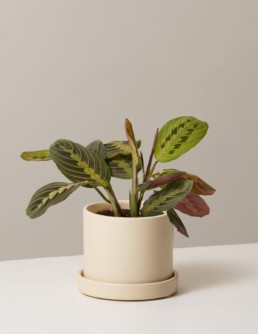
Prayer Plant (Maranta)
Nicknamed the ”prayer plant”, the Maranta is famous for the unique movements of its dramatic foliage.
Prayer plants are some of the most beautiful houseplants you can find. Their large, variegated leaves create stunning displays in hanging baskets or macrame sets as they spread low and wide. Even more stunning is that at dusk, the leaves fold together on an upward motion, as if in prayer. This variegated Maranta is the traditional example of a Prayer Plant displays various shades of green with rich red veins running through them and forming elegant patterns that change as these mature with the plant.
This plant is recommended by NASA’s Clean Air Study for it’s air purifying attributes. Add one (or a combination of different purifying plants) for every 100 sq. ft. of indoor space and say goodbye to 90% of your indoor toxins!
Light
Thrives in high to medium indirect light. Not suited for intense, direct sun.
Water
Water every 1-2 weeks, allowing soil to dry out between waterings. Increase frequency with increased light.

Philodendron Green
The Philodendron Green is characterized by its heart-shaped trailing leaves. It is a great choice for beginners.
Philodendrons are common houseplants that are also known to remove harmful chemicals from the air, formaldehyde being its chemical of choice to remove from the air.
Philodendrons are easy to maintain and will make any room look great with their big dark green leaves.
Heart-leaf philodendrons are often grown in hanging baskets which allow the thin stems and heart-shaped leaves to beautifully spill out of their container. They can also be trained to climb up a screen, trellis, pole, or a bark board. Hybrid philodendrons differ in that they have much larger, spade-shaped leaves and a more upright growth habit. These “tree” philodendrons can bring a tropical touch to your home.
Some philodendrons, including heart-leaf philodendron, contain a chemical that can be toxic if eaten, so be sure to keep these plants away from pets and children.
Light
Thrives in high to medium indirect light. Not suited for intense, direct sun.
Water
Water every 1-2 weeks, allowing soil to dry out between waterings. Increase frequency with increased light.
Now that you know what plants that you can start using for your home or office, what are you waiting for? We feel that people who do not have indoor plants are missing out on the wonder benefits.
Get one, or even five, and start the process of greenification for your home and office.
If you need some idea on what kind of plants that you can use for your buildings, lobbies or office interiors, you can start by checking out our Case Studies on projects that we have worked on.
If you have any other questions, feel free to contact us. Our team will be more than happy to help.
